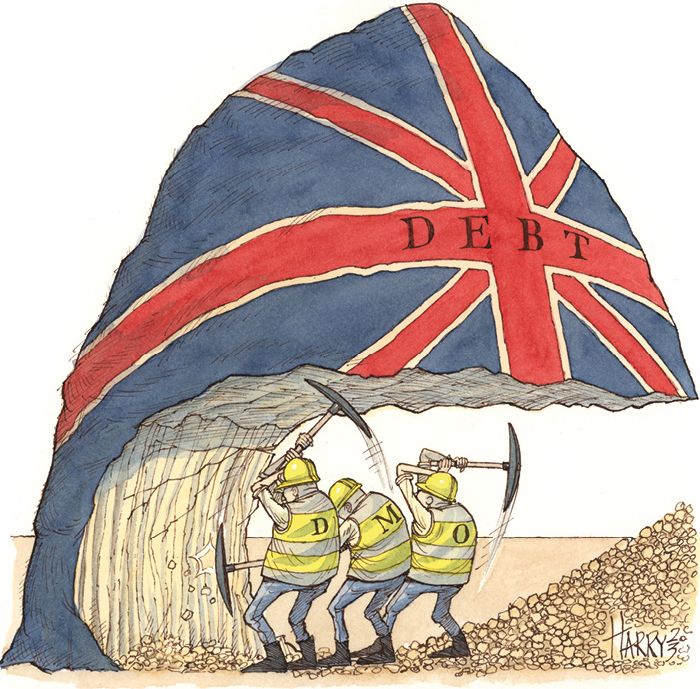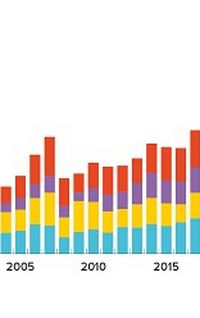So-called perfect storms are becoming more frequent in the financial world. The UK will need to tread carefully to avoid being caught in another one.
![]()
Calm seems to have returned to the market for UK government bonds after the turbulence induced by the short but catastrophic administration of Liz Truss that meant the UK was hours away from a meltdown in some of its major non-bank financial institutions.
Indeed, Gilts are enjoying an unexpected purple patch after autumn's unprecedented volatility. But the return of an orderly market could well prove fleeting as huge supply looks set to increase risk again in 2023, meaning there could still be more trouble ahead as the market attempts to absorb the government’s huge funding requirement.
The Office for Budget Responsibility's projections for UK gross funding have ballooned for the 2023–24 financial year from April to £305bn, double that of the previous year. Net Gilt supply – that is issuance by the Debt Management Office, fewer redemptions and the unwind of quantitative easing by the Bank of England – could easily be £250bn.
“In the fiscal year ahead we expect to get an all-time record supply of Gilts, net of QE/QT. And it's likely to be a record number by a very long way," said David Parkinson, a sterling rates product manager at RBC.
Which prompts an obvious question. "Who is actually going to buy all those Gilts and are we going to have to see higher long-term premiums, and new issue premium to sell the Gilts?" asked Paul Rayner, head of government bonds at Royal London Asset Management.
Thus far, the BoE's intervention to restore order to a panicking Gilt market in the aftermath of September’s “Truss up” (to use one of the more polite terms Gilt market lags have for the now infamous "mini-budget") seems to have done the trick.
Average daily traded volume was £11.35bn in September and the next month rose further to £12.1bn, according to Tradeweb data. The average for the previous six months had been £6.7bn. Levels haven’t returned to normal, but they’re not far away: average daily volumes for November fell to £8.48bn and declined to £7.59bn in December.
Similarly, benchmark yields have moved a long way towards where they were (although they had already risen considerably even before the mini-budget debacle). The 10-year yield is down to 3.30% from the 4.63% high in early October, and it is a similar story for the two-year, which peaked at 4.70% but is now around 3.40%. At the long-end, the 30-year is hovering around 3.70% from a lofty 5.10%.
Bouncing back
That retracement of yields combined with the fact that the DMO's sales in the first quarter both by auction and syndication have been well received gives some comfort that the market has bounced back and long-term scarring will not be too great.
But there are reasons for caution. First, net Gilt supply has actually been relatively light so far this year, amid substantial redemptions. And second, the bond market rally has mostly been a global one, apparently caught short by falling inflationary expectations.
So what if inflation significantly overshoots? Any market correction in optimistic views on where central banks' rates will terminate would be sharp in Gilts.
"There is a widespread view that there isn't much premium left in the UK market compared to immediately after the LDI crisis but I'm not sure that is totally accurate," said Mike Riddell, a senior portfolio manager at Allianz Global Investors.
He points out, for example, that high coupon Gilts are yielding more than low coupon Gilts – for the same maturity. And those high coupon Gilts were largely held by a specific class of pension funds – those following liability-driven investment strategies – that were at the centre of September’s storm as they were forced to sell Gilts to fund massive margin calls.
"The footprint of distress is still there," he said.
David Zahn, head of European fixed income at Franklin Templeton, expects more volatility, for bond markets more generally but also Gilts in particular.
"I still think there's a premium in the market that needs to come down for Gilts. But that will take some time and will also be dependent on what the government does."
There is good news in that the LDI space has deleveraged considerably and operators have put in place much larger liquidity reserves so a repeat of last year's woes is highly unlikely. One market watcher said it would take moves three or four times the size of last autumn to burn though newly bolstered LDI buffers.
The fragility was caused by leverage and crowded position taking, a phenomenon that is always fraught with risk. The UK pension sector's dominant position in long-dated and index-linked Gilts is stark: in the fiscal first quarter of last year, pension funds held more than a quarter of Gilts with 25 years or greater maturity and they were packed in like sardines in linkers, owning nearly three-quarters, according to data from the Financial Survey of Pension Schemes carried out by the Office for National Statistics.
Reappraisal
This congestion was already starting to be unwound before the crisis and the trend is set to continue, as a comprehensive reappraisal of risk and the tactics used by the pension sector reverberates across UK fixed-income markets.
"I think there's structural change under way in the pattern of demand in the Gilt market, which is one of the challenges that the market will have to navigate," said Parkinson. "Over the last 25 years there has been a persistent demand for long Gilts from pension funds.
“I think what was already just starting to happen – before the market stress after the mini-budget – was that the intensity of that demand was slowing."
Over the next 10 years pension risk transfer is likely to accelerate with pension funds shifting their liabilities to insurance companies, which will use swaps rather than Gilts to hedge liabilities because it's more capital efficient.
The implications could be critical as demand from pension funds for long-dated and index-linked Gilts has been responsible for the persistent inversion in the curve, effectively providing a massive subsidy for the government for over two decades.
"The pension funds are not going to stop buying Gilts overnight, but I think the intensity of that demand that made the Gilt market different from most of the other G7 bond markets is in the process of changing," said Parkinson.
There are contradictory forces at work. While demand for the long end could wane in the manner Parkinson and others describe, this could be countered by pension funds and other investors buying Gilts outright, based on their new-found attractive levels.
While those dynamics play out, another, perhaps more pertinent question needs answering: who is the marginal buyer of Gilts and what entices them to invest?
"You have to think it’s the international buyers. And I'm not sure they are over the crisis," said the head of debt capital markets for SSAs at a large bank. "Gilt yields are going to have to rise. The question is by how much and how quickly.”
To see the digital version of this report, please click here
To purchase printed copies or a PDF of this report, please email leonie.welss@lseg.com
















